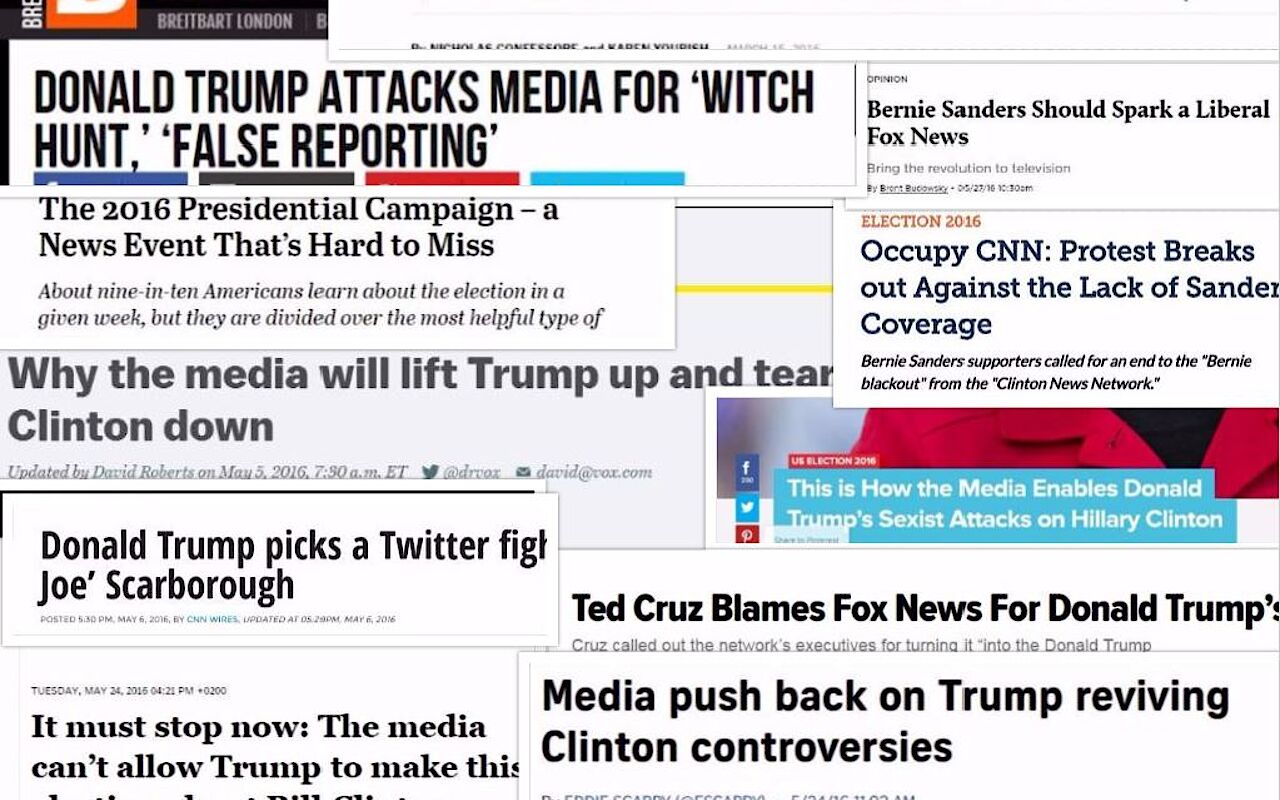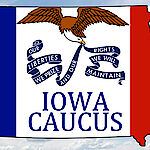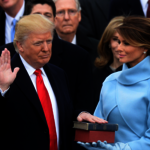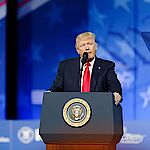More Money – More Problems: The 2016 Presidential Election and the Media
The Atlantic Academy’s Road to the Elections No. 5
Curd Knüpfer, Free University Berlin
About this Series
On November 8, nearly 200 Million registered voters are called upon to elect the next President of the United States of America, all 435 members of the House of Representatives as well as thirty-four of the one hundred senators. As in 2008, there is no incumbent, which is why both parties, the Democrats and the Republicans, will determine their candidates in primary elections. Thus, maybe fundamental changes but at least new accents in some policy fields should be expected.
With a monthly publication series, the Atlantic Academy will focus on this road to the elections in November. Political and economic scientists analyze policy fields as well as their roles in the (primary) elections and formulate expectations for a new presidency and Congress.
When surveying the media landscape from the vantage point of 2016, two trends immediately stand out: One is the ongoing process of media fragmentation by which the era of broadcast news has been replaced with a much more diverse information environment. The second trend line is the enduring crisis of professional journalism. What ties these two developments together and makes them especially salient in times of political election cycles seems to be the mediating force of money, as shall be argued and demonstrated below.
Today’s media system appears to be as abundant as never before. News consumers (aka the American public) have access to an unprecedented amount of media channels, via cable, broadband internet, satellite radio, as well as the still existing, more traditional venues. This abundance has resulted in a segmentation of the audience, which is increasingly free to choose between various news sources and typically flocks to those that reflect their own ideological preferences (Mancini 2013). Regarding the presidential race and election coverage, this can cause diverging audiences to come into contact with a very different set of information, by which they are left with starkly diverging impressions of who the candidates are. Compare, for example, news coverage of Hillary Clinton on CNN to coverage of the same candidate on Fox News, and two very different sets of facts and news frames will emerge.
What has been particularly striking about the 2016 race is that even already segmented news environments, epitomized by cable channels such as Fox News or MSNBC, have become further divided along the lines of candidates that are perceived to be part of the Republican or Democratic mainstream and the ostensible outsiders like Donald Trump or Bernie Sanders. Meanwhile, virtual communities on social media like Facebook or via Reddit threads increasingly establish themselves as the news aggregates of choice for those who feel that media coverage has been failing their respective candidate. What these alternative media sites point to again and again, is that the apparent abundance of the ‘new’ mass media environment might well be a very superficial one: While information sources have become more numerous, the trend line towards increased media consolidation has held steady since the 1980s (Corcoran 2016). This means that less and less owners hold an ever-increasing share of media infrastructures and real estate.
The second important trend to consider in regard to election coverage is therefore the ongoing crisis of professional journalism. As established news outlets have lost massive parts of their market share, they have struggled to maintain a level of professionalism and editorial autonomy (McChesney & Nichols 2011). This is quite literally bad news for anyone interested in hard-hitting and research-intensive background information on any of the candidates or their proposed platforms. However, these developments have been a boon for campaigns and their PR departments. While television remains Americans’ news source of choice (Saad 2013), this is also a medium that is both expensive to produce and at the same time heavily reliant on material such as events and sound bites. During election cycles, media outlets looking for precious bits of information – whether these are events to cover or debates to mediate – are given ample opportunity to invite candidates, cover rallies or conventions, tally up delegates and report on particularly spiteful attacks between political opponents. Based on media coverage, election cycles have continually become longer, while political sound bites have become shorter (Hallin 1992), and the vast majority of political ads have become negative (Washington Post 2012). These underlying sets of interests have led to new forms of media logics which have managed to influence how campaigns are run and which type of candidate will be particularly successful in setting the agenda.
In this election cycle, there has so far been one clear outlier who was clearly able to benefit most from these media-campaigning logics. Donald Trump has been the unrivalled champion of securing what insiders refer to as “earned media” – coverage and airtime that a campaign receives, which is not paid for but rather afforded to them via the news agenda. Based on data collected via the Tyndall Report for the early months in 2016, Trump received “more airtime (175 minutes) than all other candidates combined (Hillary Clinton, 60; Bernie Sanders, 44; Ted Cruz, 32 (…)” (Tyndall 2016). Interpreting these figures, Tyndall goes on to argue that they might result from a combination of what the media need and what Trump delivers. This includes newsworthiness, the perfectly placed sound bites he delivers, the simplicity of his script, his willingness to provide the media with the above, his somewhat exotic status as an underdog candidate different from the rest, but also the genuine groundswell among conservative Americans that he has been able to rally to his cause.
Meanwhile, it should be noted that Bernie Sanders, whose successes in the Democratic primaries have been almost equally impressive and possibly even more surprising, does not seem to be able to benefit from the same media dynamics. In fact, the Sanders campaign’s experience seems almost diametrically opposed to Trump’s when it comes to mainstream media coverage. While the campaign has set records for contributions, scored unexpected victories in key primary states, and has consistently received the highest marks for public interest based on internet searches, mainstream media coverage of Sanders has been almost entirely eclipsed by a focus on Hillary Clinton (Whitaker 2016). And yet, as data by the 2016 Campaign Television Tracker shows, even when mentions in TV news for Clinton’s (250k) and Sanders’ (132k) are aggregated, they still lag far behind the amount of focus that Donald Trump has received (510k).
In regard to the developments pointed out above, it may therefore be fair to state that the Trump campaign’s success can be seen as directly related to the two phenomena introduced above: Firstly, media fragmentation has ensured that a segment of devoted followers could circumvent mainstream coverage and may come to hold a very different view of Trump than a majority of Americans.
Meanwhile, and secondly, the crisis of journalism as described above has ensured that a candidate of reality television fame and habitus seems to exhibit the perfect blend of qualities that will ensure sustained media coverage and can come to set the agenda of more mainstream oriented outfits. In the words of the CEO of one of the biggest broadcasting corporations in the US, Trump’s success “may not be good for America, but it's damn good for CBS” (Bond 2016).
However, the win-win symbiosis of media and campaign interests does not begin nor does it end with Donald Trump. Apart from information and material to cover, media outlets are dependent on advertising dollars. Therefore, the good news for what Andrew Cockburn has dubbed “the election-industrial complex” (2016) is that the current election cycle is projected to be the most expensive on record, meaning that a lot of money will change hands. Some commentators have likened these developments to “a perfect storm of conditions,” (Littleton 2015) by which novel possibilities of targeted adverts, specifically catered to a segmented audience, can be agreed upon by a relatively small number of media executives and deep-pocketed Super PACs. TV spending is consequently “projected to hit $4.4 billion for the 2016 election cycle, encompassing federal and state races, up from $3.8 billion in 2012” (Littleton 2015).
However, there may be a silver lining to these developments, based on the question of how effective political ads even are. Jeb Bush’s super PAC, for example, “spent almost $65 million before the first primary vote was cast and yielded wretched showings in Iowa, New Hampshire, and South Carolina before the candidate finally pulled the plug” (Cockburn 2016). In fact, as years of media-effects scholarship have convincingly demonstrated (cf. Neuman & Guggenheim 2011), people are not easily persuaded to agree with a message they do not already hold to be (at least partially) true. However, while the idea of billionaires and hedge funds burning money on futile advertisements might occasionally lead to gleeful commentary, a more indirect problem might persist. While the effects of ads and messages citizens do see may remain fairly inconsequential, the potential issues that are routinely left out of mediated discourse and media consumers therefore do not come into contact with may be of greater concern.
For a democratic system, the central problems posed by the developments outlined above are easily made out: they center primarily on questions of accountability and transparency. For the past decades and especially since the 2010 Citizens United ruling, murky campaign finance regulations have increasingly been coupled with symbiotic relationships between donors, political action committees, candidates and media enterprises – all of which may have little to no interest in making their mutual interests and connections known to the public. Even the old investigative adage of “follow the money” no longer seems to be feasible, when loopholes for dark money campaign finance abound. Meanwhile, the media, i.e. the ostensible platforms of democratic and public deliberation, are increasingly transformed into real estate for political ads rather than functioning as critical watchdogs for the democratic process.
While such trends can be observed for national elections, on a local and state level, things seem even more fraught. For example, media analysis of various local television news channels, which heavily featured ads by political action committees in 2012, revealed “a near-complete station blackout on local reporting about the political ads they aired” (Stelter 2013). Covering the Baltimore mayoral race in April 2016, an investigative reporter working for the Baltimore Sun described his frustration: “Given the current rules of disclosure, you can never get the full amount or all the sources of the dark money. Online buys do not require any disclosure. Cable disclosure is an obstacle course” (Zurawik 2016). As he goes on to explain, federal election rules only require television stations to release sales information on adverts dealing with “a national legislative issue of public importance” – a requirement that leaves ample interpretative leeway for those who choose to obfuscate their involvement on a local level.
Somewhat ironically, it would ultimately be up to the very same candidates running for political offices to alter or fundamentally reform the system. While history has shown that it is not easy for any synergistic relationship between powerful interests to be regulated or divided, campaign and media reform might be a particularly hard nut to crack. For obvious reasons, campaign spending is directly related to media content. Aspects of it can therefore easily be depicted and interpreted as a First Amendment issue, which makes for difficult terrain in regards to lawmaking as well as regulating.
Nevertheless, media are increasingly becoming an important campaign issue. This may be attributed to the changing dynamics of the media environment, which has seen the rise of a powerful tech sector that is increasingly responsible for both the communication infrastructures as well as the content being exchanged. The perhaps most prominent issue currently being discussed is the concept of net neutrality and the Federal Communication Commission’s (FCC) enforcement thereof. While the Obama administration and the Democratic candidates have come out strongly in favor of net neutrality, the Republican field has been mostly dismissive of the concept (Edwards 2015).
For large economic sectors such as the entertainment industry, “Silicon Valley,” or internet service providers, even small tweaks in regulatory discretion can have momentous effects. It should therefore come as no surprise that the tech and media industries have become incrementally involved in lobbying and campaign finance activities. Data made available via the website OpenSecrets.org shows that tech- and net industries lobbying efforts have “grown by more than $100 million since 1998 to meet the demands of an ever-expanding list of interests” (Mindock 2015). In the 2016 election, the communications and electronics sector has spent around 40 million USD so far, of which almost half (18 million) have gone to the Clinton campaign (OpenSecrets 2016a). A similar picture emerges when it comes to the TV, movies and music industries, where 9 out of a total of 14 million USD have been invested in Clinton so far (Opensecrets 2016b). As those of a quizzical mindset might be inclined to point out in light of these figures, there seems to exist an interesting parallel to the overrepresentation this particular candidate has received in terms of mainstream media content.
Whether or not there may be any merit to such (possibly overly simplistic) speculation, the mere fact that media content, political campaigns and media enterprises are so closely connected to one another may appear troubling for the reasons touched upon above. In the final analysis, the medium by which the three cornerstones of the “election-industrial complex” (Cockburn 2016) remain linked is perhaps as old as Western civilization: Money is what keeps it all connected – and it would appear that the more of it circulates, the closer the connections will become.
Bibliography
Bond, Paul (2016): Leslie Moonves on Donald Trump: "It May Not Be Good for America, but It's Damn Good for CBS" (February 29), The Hollywood Reporter, www.hollywoodreporter.com/news/leslie-moonves-donald-trump-may-871464.
Cockburn, Andrew (2016): "Down the Tube: Television, Turnout, and the Election-industrial Complex." Harpers Magazine (April 2016 Issue), harpers.org/archive/2016/04/down-the-tube/.
Corcoran, Michael (2016): Twenty Years of Media Consolidation Has Not Been Good For Our Democracy (March 30), BillMoyers.com, billmoyers.com/story/twenty-years-of-media-consolidation-has-not-been-good-for-our-democracy/.
Edwards, Haley Sweetland (2015): Why 2016 Republicans Oppose Net Neutrality. (March 13), Time. time.com/3741085/net-neutrality-republicans-president/.
Hallin, Daniel C. (1992): Sound Bite News: Television Coverage of Elections, 1968–1988. Journal of Communication 42. 5–24.
Littleton, Cynthia (2015): Local TV Stations Ready to PAC in Cash as Election Season Gears Up (October 28), Variety, variety.com/2015/tv/features/political-ads-local-tv-pac-1201628302/.
Mancini, Paolo (2013): Media Fragmentation, Party System, and Democracy. In: The International Journal of Press/Politics. 18 (1):43-60.
McChesney, Robert W. und John Nichols (2011): The Death and Life of American Journalism: The Media Revolution That Will Begin the World Again. New York: Nation Books.
Mindock, Clark (2015) “West Coast, East Coast: Silicon Valley Blurs the Distinction with Washington Presence. (March 6), OpenSecrets.org, http://www.opensecrets.org/news/2015/03/west-coast-east-coast-silicon-valley-blurs-the-distinction-with-washington-presence/.
Neuman, W. Russell, and Lauren Guggenheim (2011): “The Evolution of Media Effects Theory: a Six-Stage Model of Cumulative Research.” Communication Theory 21 (2): 169–96.
OpenSecrets (2016a): Communications/Electronics Sector Totals to Candidates, https://www.opensecrets.org/pres16/select-sectors.php?sector=B.
OpenSecrets (2016b): Selected Industry Totals, https://www.opensecrets.org/pres16/select-industries.php?ind=B02.
Presidential Campaign 2016: Candidate Television Tracker (2016), accessed May 6. 2016, available online at, http://television.gdeltproject.org/cgi-bin/iatv_campaign2016/iatv_campaign2016.
Saad, Lydia (2013): TV Is Americans' Main Source of News. Gallup. http://www.gallup.com/poll/163412/americans-main-source-news.aspx.
Stelter, Brian. "Campaign Ad Cash Lures Buyers to Swing-State TV Stations." The New York Times. July 07, 2013. Accessed May 05, 2016. www.nytimes.com/2013/07/08/business/media/with-political-ad-profits-swing-state-tv-stations-are-hot-properties.html.
The Washinton Post (2012): Mad Money: TV ads in the 2012 presidential campaign, (November 12.), http://www.washingtonpost.com/wp-srv/special/politics/track-presidential-campaign-ads-2012/.
Tyndall, Andrew (2016): Why Donald Trump Is King of All Earned Media (Guest Column) (March 16), The Hollywood Reporter, www.hollywoodreporter.com/news/why-donald-trump-is-king-876134.
Whitaker, Ryan (2016): 2016 Presidential Media Blackouts: Not Just Conspiracy. (January 12), Decision Data, decisiondata.org/news/political-media-blackouts-president-2016/.
Zurawik, David (2016): Want to follow the money behind political ads? Good luck finding it. (April 29), Baltimore Sun, www.baltimoresun.com/entertainment/tv/z-on-tv-blog/bs-ae-zontv-media-money-20160429-story.html.
About the Author
Curd Knüpfer currently works as a lecturer at the John F. Kennedy Institute (JFKI) and the Freie Universität Berlin, filling in for the position of assistant professor of North American Foreign Policy. He completed his doctoral research on right-wing media coverage of US foreign policy at the JFKI’s Department of Political Science in early 2015. Before coming to Berlin, Curd Knüpfer received his Magister degree in 2010 from the University of Bonn’s North American Studies Program. The author’s main areas of academic interest lie in US foreign policy and political communication, with a focus on dynamics of media fragmentation and political polarization. His post-doctoral project seeks to uncover the mechanisms by which issues become politicized and instances of intense frame competition occur and spread within online discursive environments.







